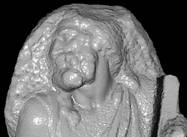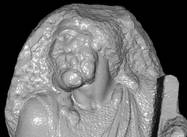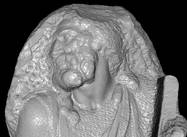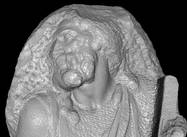

|
The QSplat Multiresolution Point Rendering System |
|---|
QSplat is a program for displaying large geometric models in real time. It was originally designed during the course of the Digital Michelangelo Project, to render the hundred-million-polygon models we were producing. It features:
QSplat is available for research and commercial use, free of charge, as described at the bottom of this web page.
Here is a sequence of images showing QSplat renderings of a model of Michelangelo's St. Matthew. At left is the model as it would appear during interactive manipulation. At right is the model in its highest-quality refined version. Click on the images to bring up full-resolution versions.

130,712 splats 132 ms |

259,975 splats 215 ms |

1,017,149 splats 722 ms |

14,835,967 splats 8308 ms |
|---|
For a more detailed description of QSplat, please see "QSplat: A Multiresolution Point Rendering System for Large Meshes", presented at SIGGRAPH 2000.
A network-streaming version of QSplat is described in "Streaming QSplat: A Viewer for Networked Visualization of Large, Dense Models", presented at the 2001 Symposium on Interactive 3D Graphics.
Slides from the QSplat talk at SIGGRAPH 2000 are here. Slides from the streaming QSplat talk at I3D 2001 are here.
QSplat source code and binaries are available here (for academic and research use only).
This page translated into Belorussian, by Patric Conrad.
This page translated into Spanish, by Maria Ramos (with support from Webhostinghub.com).
During the period 1995-2007, this software was covered by the Stanford Computer Graphics Laboratory's custom-written General Software License. This license is royalty-free, nonexclusive, and nontransferable. Click here to view its terms and conditions. In modification of these terms and conditions, users were permitted to distribute or sell derivatives of this software without accounting to Stanford or the developers, and without payment of royalties to Stanford or the developers. However, title and copyright to the software and documentation remained with Stanford, and users were required to acknowledge the contribution of Stanford in any derivatives, as detailed in the license.
For downloads beginning on August 23, 2007, this software is covered by a new General Software License, which is based on the BSD license.
The images of Michelangelo's statues that appear on this web page are the property of the Digital Michelangelo Project and the Soprintendenza ai beni artistici e storici per le province di Firenze, Pistoia, e Prato. They may not be copied, downloaded and stored, forwarded, or reproduced in any form, including electronic forms such as email or the web, by any persons, regardless of purpose, without express written permission from the project director Marc Levoy. Any commerical use also requires written permission from the Soprintendenza.